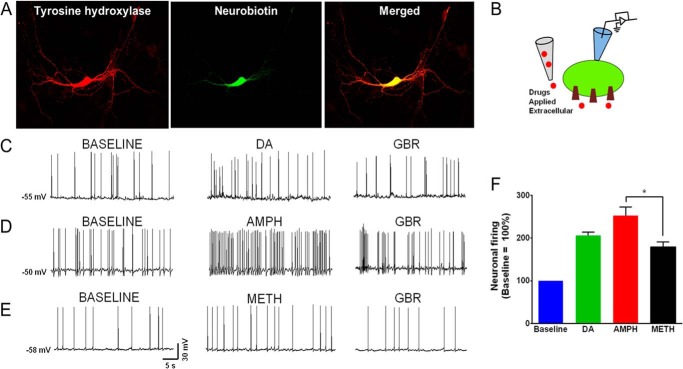FIGURE 1.
Extracellular amphetamine and methamphetamine differentially affect the DAT-mediated spontaneous firing of dopaminergic neurons. A, a representative image of a TH and neurobiotin immunoreactive dopaminergic neuron obtained from primary culture of midbrain region of 1–2 days old mice. The neurons were selected by morphological (bright cell bodies, long processes) and electrophysiological signature (D2-induced hyperpolarization). The neurons were filled with neurobiotin via the patch pipette during the recording for subsequent staining for TH and neurobiotin. The data obtained from TH and neurobiotin-immunoreactive neurons are reported. Neurobiotin is widely used to identify the neurons from which the recordings were performed and does not affect the electrical properties of neurons (54). The spontaneous firing activity of midbrain dopaminergic neurons was measured in the current clamp mode when D2 receptor is blocked (sulpiride, 5 μm). B, the schematic depicts the experimental configuration showing DAT substrates were applied extracellularly. C–E, representative traces of current clamp recording of midbrain dopaminergic neurons show the basal spontaneous firing activity of dopaminergic neurons at resting membrane potential in the absence of DAT substrates, dopamine, amphetamine, or methamphetamine. The extracellular application of DAT substrates, dopamine (1 μm; n = 5), amphetamine (1 μm; n = 5), or methamphetamine (1 μm; n = 5), increases the firing rate of dopaminergic neurons that is blocked by DAT antagonist, GBR12935 (GBR; 1 μm). F, bar graphs show the spontaneous neuronal firing rate after extracellular drug application. The data are normalized to the spontaneous firing rate at base line before drug application. The reported base line (100%) is not an interleaved base line. Although the amphetamine- and dopamine-induced increases in the spontaneous firing rate of dopaminergic neurons were similar, the methamphetamine-induced changes in the firing rate was significantly lower than amphetamine (*, p < 0.05, one-way ANOVA followed by Tukey's post hoc test).

